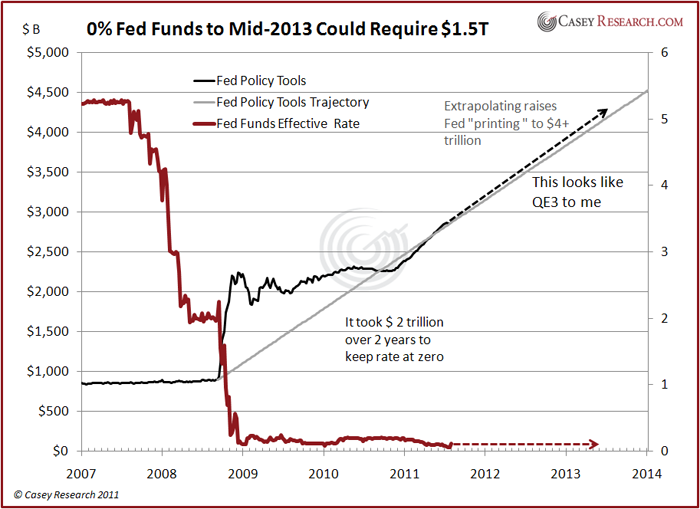Has the Fed Already Started QE3?
Interest-Rates / Quantitative Easing Aug 26, 2011 - 12:59 PM GMTBy: Casey_Research
Bud Conrad, Casey Research Writes: The Fed surprised the market by extending its policy of 0 to 0.25% Fed funds rate to mid-2013. The way the Fed manages to drive rates lower is to buy Treasuries with newly created money – driving the price up and the rates down. The big question is whether the policy will have a sizeable effect on markets. The chart below shows the historical jump in the Fed’s combined policy tools that were used to lower rates and bail out financial institutions through a variety of programs. These include the big purchase of mortgage-backed securities (MBS) called QE1 and the large purchase of Treasuries called QE2.
The point of the extrapolation in the chart is just to guess how much more money the Fed might need to create to keep the rate extremely low for another two years. By connecting a straight line from the start of the unusual policy tool expansions in late 2008 to today’s number, and then extending it to 2013, we can estimate that the policy might require about $1.5 trillion in order to keep the rate low.

The Fed doesn’t calculate the amount of money that might be required and probably doesn’t know for sure. They just keep buying on the open market until the rate comes to its target. If there were a loss of confidence in the dollar, the amount could become very large – and in the extreme, printing more money contributes to that loss of confidence, which in turn causes runaway inflation. We are not there yet. But this kind of open-ended promise is a dangerous precedent because we can’t be sure of the cost of the commitment.
However, we can say that the Fed policy is to let the dollar fall and to support the bankers and politicians who want to stimulate the economy.
[Many analysts at Casey Research foresaw the problems that are playing out today with US debt and the dropping value of the dollar. Join Bud, Doug Casey, other Casey Research experts, and special guests including John Mauldin and Mike Maloney in a free online event focusing on the American debt crisis – including how you can protect yourself and your wealth.]
© 2011 Copyright Casey Research - All Rights Reserved
Disclaimer: The above is a matter of opinion provided for general information purposes only and is not intended as investment advice. Information and analysis above are derived from sources and utilising methods believed to be reliable, but we cannot accept responsibility for any losses you may incur as a result of this analysis. Individuals should consult with their personal financial advisors.
© 2005-2022 http://www.MarketOracle.co.uk - The Market Oracle is a FREE Daily Financial Markets Analysis & Forecasting online publication.



